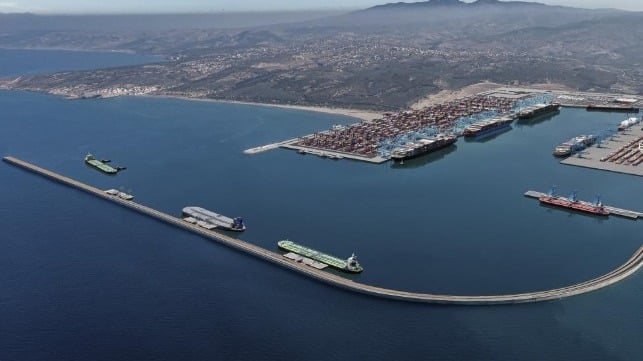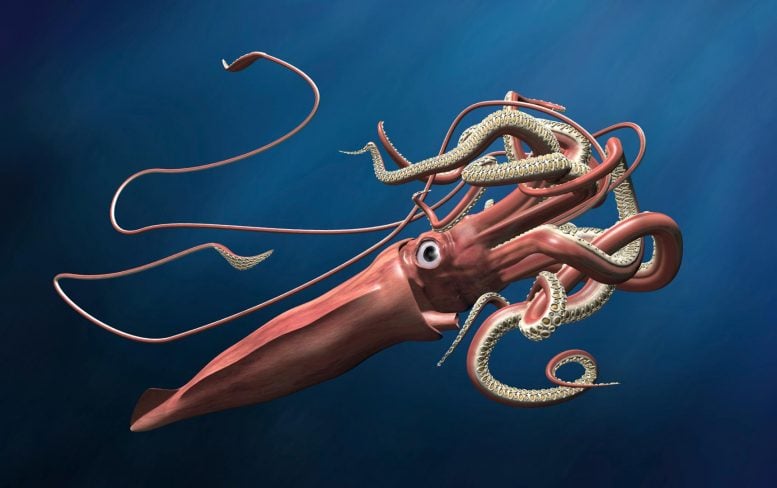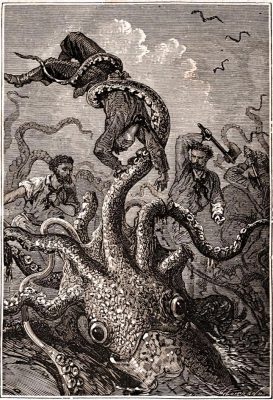Timothy Jones
French author Jules Verne gave us some astoundingly accurate predictions of future technological advances. His stories inspired many scientists and inventors to make his visions a reality.
When French author Jules Verne died in 1905, powered air flight, which he put at the center of his 1886 book "Robur the Conqueror," had moved from fiction to reality. Just two years earlier, the Wright brothers had achieved the first manned air flight in human history.
Yet more of Verne's predictions of world-changing technologies were still far from being realized when he died. Being able to orbit the moon on a spaceship, as he depicted in his 1865 novel "From the Earth to the Moon," seemed like a distant fantasy. But it came true just 60 years later with NASA's Apollo 8 mission in 1968.
Verne's brilliance lay in the way he vividly imagined how existing technologies might be developed, then embedded his ideas in exciting adventure stories.
This fascinating combination of fact and fiction have made Verne's novels ideal for stimulating interest in science and technology, despite all the progress since they were written. That's why Verne’s stories have inspired countless scientists and inventors, and continue to do so today. Here are four such examples.
Simon Lake (1866-1945), submarine designer
Simon Lake was a US naval architect who designed some of the first submarines for the US Navy. He said he was indebted to Verne, in particular the novel "Twenty Thousand Leagues Under the Seas" (1869-1870), which he first read at the age of 10 or 11.
This book features the Nautilus, an undersea vessel far more advanced than the rudimentary submarines that existed when the book was written.
Lake was gripped with the ambition to build a submarine that matched or exceeded the Nautilus in its performance.
He made some progress, designing a submarine called the Argonaut. A successful 1,000-mile (1,600-kilometer) voyage of the Argonaut in 1898 earned Lake the delight of receiving a congratulatory telegram from Verne himself.

Later, Verne's grandson, Jean Jules Verne, was invited to be a "godparent" of one of Lake's later, more advanced submarines. The vessel was even rebaptized as the Nautilus ahead of an Arctic expedition in 1931, in honor of the French author.
Alberto Santos-Dumont (1873-1932), aeronaut and inventor
Brazilian inventor Alberto Santos-Dumont not only designed and built some of the first powered airships, but also flew them. Among his many trips, he circled the Eiffel Tower in Paris with his airship No. 6 in 1901, a performance which brought him great fame across the world at the time.

Santos-Dumont went on to design, construct, and fly powered aircraft like gliders and ornithopters. He carried out a flight of 220 meters (241 yards) at a height of 6 meters (20 feet) in his 14-bis in November 1906.
In his book, "My Airships," Santos-Dumont mentioned several of Verne's works as inspirations for his curiosity about the world and technology, calling the French writer the "favorite author" of his youth.
Igor Sikorsky (1889-1972), aviation pioneer
Igor Sikorsky's mother, Mariya Stefanovna Sikorskaya, instilled a love for Verne's stories in the Russian-American aviation pioneer.
In particular, "Robur the Conqueror," with its vividly described aircraft, inspired Sikorsky to build the helicopters for which he became famous.
After several failed attempts early in the 20th century, Sikorsky succeed in designing and flying the Vought-Sikorsky VS-300, the first workable American helicopter, in 1939.

The early form of a helicopter was modified to become the Sikorsky R-4, the first mass-produced helicopter in the world.
Sikorsky also designed numerous fixed-wing airplanes, mostly after he emigrated from Russia to the US in 1919 after the 1917 Russian Revolution.
Konstantin Tsiolkovsky (1857-1935), rocket scientist
Konstantin Eduardovich Tsiolkovsky, one of the pioneers of modern rocketry and astronautics, named Verne as the person who inspired his interest in space flight.
Tsiolkovsky also emulated Verne as a writer, publishing the novel "On the Moon" in 1893. He also wrote many philosophical and scientific works related to space travel and the human relationship with the cosmos.
Verne's fictional depictions of spaceships carrying lunar voyagers as a shell shot from a cannon could never succeed in reality. In contrast, Tsiolkovsky developed theories on many principles of rocket propulsion and space travel that are workable and still hold true today.
Like Verne, Tsiolkovsky was convinced humans would one day move out further into the solar system.
"Man will not always stay on Earth; the pursuit of light and space will lead him to penetrate the bounds of the atmosphere, timidly at first, but in the end to conquer the whole of solar space," reads the epitaph on his obelisk that Tsiolkovsky himself wrote.
Edited by: Fred Schwaller
Jan. 3, 2025

An Indian PSLV-C60 rocket carrying Space Docking Experiment, or SpaDeX, payloads is shown lifting off from Satish Dhawan Space Centre in Andhra Pradesh on Monday. SpaDeX is a pioneering mission to establish India's capability in orbital docking.
Jan. 3 (UPI) -- India's space agency says it is planning a record 10 orbital missions, as well as its first commercial effort, during 2025 after successfully launching a space-docking project this week.
Indian Space Research Organization chairman S. Somanath told reporters following Monday's launch of a PSLV-C60 rocket carrying Space Docking Experiment, or SpaDeX, payloads, that the nation has big plans for the coming year.
"ISRO set to launch the NVS-02 satellite in January 2025, with more missions planned for upcoming year," he said on Tuesday while marking the agency's 99th launch from the Satish Dhawan Space Centre in Andhra Pradesh, which carried two small spacecraft built to dock together in space, a mission deemed as essential for India's space ambitions.
"Through this mission, India is marching towards becoming the fourth country in the world to have space docking technology," the agency said in a statement.
Among the upcoming plans outlined by Somanath are 10 missions, including the NVS-02 navigation satellite. With that "milestone" 100th launch from Satish Dhawan Space Centre, ISRO will launch the second in the series of 2nd-generation navigation satellites and the ninth satellite in its Navigation with Indian Constellation.
Similar to its predecessor NVS-01, the NVS-02 will likely have both navigation and ranging payloads which are meant to serve both civilian and military geo-positioning needs, NDTV reported.
Four other geosynchronous satellite launch vehicle missions are on the agenda for 2025, as well as a manned LVM-3 launch for India's Gaganyaan human spaceflight program, three Polar Satellite Launch Vehicle missions and a launch of the SSLV solid rocket, Somanath said.
By AFP
January 4, 2025

File photo: The interior of the Blue Origin crew capsule. — Photo: © AFP/File
Gregg Newton with Issam Ahmed in Washington
Amazon founder Jeff Bezos’s company Blue Origin is poised to launch its first orbital rocket next week, marking a pivotal moment in the commercial space race currently dominated by Elon Musk’s SpaceX.
Named New Glenn, the rocket is scheduled to lift off from Cape Canaveral Space Force Station in Florida as soon as Wednesday 1:00 am (0600 GMT), with a backup window on Friday, according to a Federal Aviation Administration advisory.
While Blue Origin has not officially confirmed the launch date, excitement has been building since a successful “hotfire” test on December 27.
“Next stop launch,” Bezos declared on X, sharing a video of the towering rocket’s engines roaring to life.
The NG-1 mission will carry a prototype of Blue Ring, a Defense Department–funded spacecraft envisioned as a versatile satellite deployment platform, which will remain on board the rocket’s second stage for the duration of the six-hour test flight.

Jeff Bezos, pictured in November 2021, founded Blue Origin two years before Elon Musk started SpaceX — but the company has progressed at a far slower pace – Copyright POOL/AFP/File Paul ELLIS
It will mark Blue Origin’s long-awaited entry into the lucrative orbital launch market after years of suborbital flights with its smaller New Shepard rocket, which carries passengers and payloads on brief trips to the edge of space.
“The market is really orbital,” analyst Laura Forczyk, founder of Astralytical, told AFP. “Suborbital can only take you so far — there are only so many payloads and customers for a quick ride to space.”
– Space barons –
The milestone will also escalate the rivalry between Bezos, the world’s second-richest person, and Musk, the wealthiest, who has cemented SpaceX’s dominance and is now in President-elect Donald Trump’s inner circle.
SpaceX’s Falcon 9 rockets have become industry workhorses, serving clients from commercial satellite operators to the Pentagon and NASA, which relies on them to ferry astronauts to and from the International Space Station.
Like Falcon 9, New Glenn features a reusable first stage designed to land vertically on a ship at sea.
The vessel, playfully named “So You’re Telling Me There’s a Chance,” reflects the challenge of landing a reusable rocket on the first attempt, Blue Origin CEO Dave Limp said on X.
At 320 feet (98 meters), New Glenn dwarfs the 230-foot Falcon 9 and is designed to carry larger, heavier payloads. It slots between Falcon 9 and its larger sibling, Falcon Heavy, in cargo capacity while burning cleaner liquid natural gas rather than kerosene and relying on fewer engines.
“If I were still a senior executive at NASA, I’d be thrilled to finally have some competition to the Falcon 9,” G. Scott Hubbard, NASA’s former “Mars Czar” now at Stanford University, told AFP, adding that increased competition could help drive down launch costs.
– Politics at play –
For now, SpaceX maintains a commanding lead, capturing the lion’s share of the market while rivals like United Launch Alliance, Arianespace and Rocket Lab trail far behind.
Like Musk, Bezos has an enduring passion for space. But where Musk dreams of colonizing Mars, Bezos envisages populating the solar system with massive floating space colonies.
Bezos founded Blue Origin in 2000 — two years before Musk started SpaceX — but the company has progressed at a far slower pace, reflecting a more cautious approach.
“There’s been impatience within the space community over Blue Origin’s very deliberate approach,” Scott Pace, a space policy analyst at George Washington University and a former member of the National Space Council, told AFP.
If successful, New Glenn will offer the US government “dissimilar redundancy” — alternative systems that provide backups if one fails, said Pace.
This could prove vital as SpaceX plans to retire Falcon 9 by the end of the decade in favor of Starship, a prototype that relies on not fully proven technologies.
Musk’s closeness to Trump has raised concerns about potential conflicts of interest, especially with private astronaut Jared Isaacman — a business associate of Musk — slated to become the next NASA chief.
Bezos, however, has been making his own overtures, paying his respects to his former foe during a visit to the president-elect’s Mar-a-Lago residence, while Amazon has said it would donate $1 million to Trump’s inauguration committee.






